Techniques Used
The SIL utilises a range of isotope systems to assess and/or better understand processes which impact on the health and quality of our environment. Isotopes provide important advantages over standard chemical techniques in cases where quantitative solutions are required.
Example Applications
Tracing Pollution in Water Using Isotopes |
|
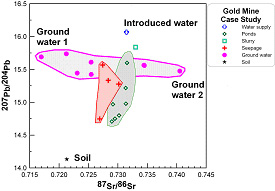 |
Rocks of different ages and compositions have different isotope compositions which may be used as tracers of pollution in water. Numerous studies utilising this have been performed in South Africa, Namibia and Madagascar, particularly to identify pollution contributions from different sources. The graph shown exhibits the Sr and Pb isotope composition of water from the city of Johannesburg, which has been polluted by gold mining operations. In this case, reworking of the old mine tailings dumps to recover residual gold was done using water cannon (introduced water) that rapidly dissolved lead-bearing pyrite in the tailings. This produced very acidic water that eroded the foundations of factory buildings down slope. The mining-related pollution was quite distinct from natural ground water in the area and it was possible to show that at least 90% of the polluted water corroding adjacent factory foundations was introduced by the mining operations. |
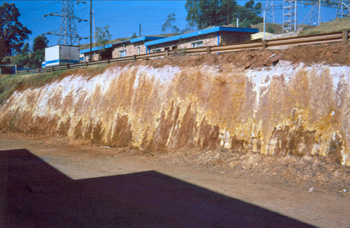 |
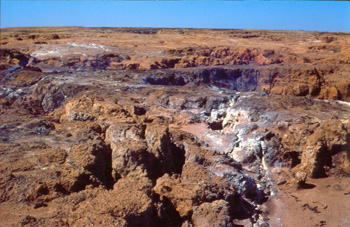 |
| The photograph above on the left illustrates the effects of seepage of acid mine drainage through an earth embankment at the boundary of a factory in the Johannesburg area (part of the study illustrated above) whereas the photograph on the right is of fractures from surface into shallow underground coal workings which spontaneously caught fire. The burning coal exacerbates the acid mine drainage problem in this area. Here too, water which has interacted with the coal has a distinctive isotope signature which is different from that in other areas. For further information, contact Bruce Eglington |
|
Assessing the Source of Water Flowing into Mine Workings |
|
 |
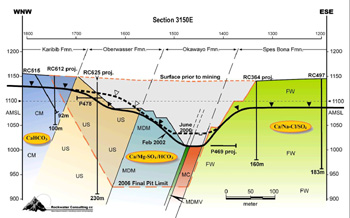 |
| View of the open pit mine at Navachab, Namibia. |
Cross-section of the mine pit, illustrating the various stratigraphic units which could be sources of water entering the mine workings. |
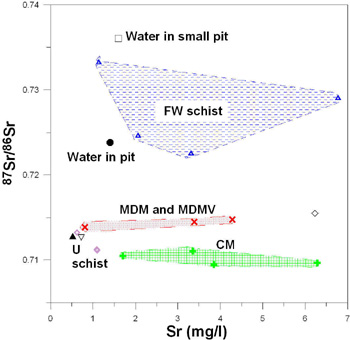 |
Water flowing into the open pit workings of the Navachab gold mine in Namibia could come from a number of stratigraphic units, several of which are karstic carbonates. However, the Sr isotope composition of water in the various units differs, permitting one to identify the origin of the water. For further information, contact Bruce Eglington at the SIL or Dr Nick Steven of RockWater Consulting |
Safe Drinking Water |
|
| Another study is an investigation into the hydrology of Ethiopian spring water sources of drinking water and recommendations for maintaining safe drinking water for the people and livestock of southern Ethiopia. For further information, contact Bill Patterson |


